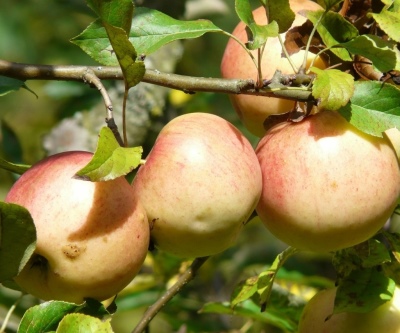
- Authors: M. A. Mazunin, N. F. Mazunina, V. I. Putyatin. South Ural Research Institute of Horticulture and Potato Growing
- Taste: sweet and sour
- Fruit weight, g: 150-200
- Fruit size: large
- Yield: up to 65 kg per tree, 226 c / ha
- Frequency of fruiting: irregular
- The beginning of fruiting varieties: 3-4 years after vaccination
- Ripening terms: winter
- Keeping quality: 110 days
- Appointment: universal
The apple tree Sokolovskoye is a dwarf variety discovered by specialists of the South Ural Research Institute of Fruit and Potato Growing. The variety appeared as a result of free pollination of the Vydubetskaya weeping apple tree.
Description of the variety
The Sokolovskoye apple tree is characterized by the following external differences:
the height of the bush on seed stocks reaches 1.5-2.0 m, on vegetatively propagated clonal stocks - 1.0-1.5;
the crown is flat-horizontal in shape;
leaves are large, dark green, covered with light nap;
branches are thick, resilient, colored greenish-brown.
Features, pros and cons
Natural dwarf varieties are good in that they do not need a large area for cultivation and grow well where high crops could not develop normally. And also the variety has the following advantages:
large fruits;
good taste;
yields are above average;
high frost resistance;
long shelf life.
The disadvantages include irregular fruiting, as well as a deterioration in the quality of the crop during a hot dry summer. And also there is a low resistance of fruit buds in relation to too low temperatures.
Ripening and fruiting
The Sokolovskoe apple tree belongs to varieties with a winter ripening period, and the first fruiting can be expected 3-4 years after grafting.
Yield
When growing a tree in a summer cottage, on average, it is possible to collect up to 65 kg of fruits from one specimen. On an industrial scale, the yield can be 226 c / ha.
Fruits and their taste
The apples are large, flat-rounded in shape, weight - 150-200 g. The skin is smooth, dry, shiny, green-yellow in color with a ruddy tint. The pulp is dense, juicy, creamy, sweet and sour taste. The marketability of the fruits lasts for 110 days, they are also characterized by good transportability.

Growing features
Due to the weak root system of dwarf varieties, it is important not to ignore some of the requirements for the planting site and soil. Choose a breathable, fertile soil type for planting. Loam and sandy loam are suitable. Best of all, the culture will develop in a sunny area.
When planting in groups, keep the distance between the seedlings at least 3 m.This will allow in the future to provide a sufficient amount of sunlight and protect against pest activity. The optimal time for planting is early spring or early autumn. When caring for the presented variety, follow a number of rules.
Perform sanitary pruning in spring and fall, and remove weak, dry, damaged shoots.
Don't ignore formative cropping. As a rule, strong shoots prevent the development of weak ones and stimulate their death.Therefore, when pruning, it is important to control their placement, leaving strong branches below the level of weak ones. This must be done on a young tree, since it will not be possible to change anything in the future.
Start feeding at the age of 2-3 years. Use minerals and organics as fertilizers, for example, an infusion of mullein or bird droppings - two buckets per bush.
Observe regular watering, especially in dry conditions. After irrigation, loosen the soil and remove the weeds. Watering continues only until the beginning of August.
The tree reacts very well to water-charging watering, which helps it survive the harsh winter.



Pollination
The presented variety belongs to non-self-fertile varieties, and therefore it needs varieties with the same ripening period. Suitable, for example, Snowdrop, Bratchud, Carpet.

Frost resistance
The Sokolovskoye apple tree has a high winter hardiness. It can withstand temperatures down to -35 degrees. The tree can be grown even in regions with harsh winters, for example, in the Urals.

Diseases and pests
This variety has good resistance to fungi and scab, but insects often prevent the tree from resting. Aphids, bark beetles, scale insects - all these pests can infect an apple tree. Most often they are eliminated mechanically. As a preventive measure, treatment with urea or copper sulfate can be used. A decoction of tobacco, garlic, nettle, mixed with soapy water, helps well against aphids. A couple of times a year, whitewashing of the bark with lime will be appropriate. If bark beetle lesions are noticeable on the trunk, then you can pour the insecticide directly into its burrow.

The apple tree is a popular fruit crop among gardeners. It can be found in many summer cottages. But at the same time, such trees are often affected by various diseases. It is very important to recognize the disease in time and carry out the necessary procedures for a speedy recovery. Otherwise, the fruits will be spoiled, and the tree itself may die altogether.












































































